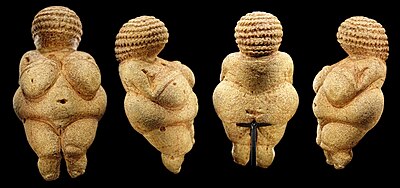The Venus of Willendorf is a Venus figurine from the Gravettian period discovered in 1908, about 11 cm tall and almost 30,000 years old. It is Austria's most famous archaeological find and can be seen in the Natural History Museum in Vienna.
Finding and description of Venus of Willendorf

The Paleolithic figurine was found by archaeologist Josef Szombathy on August 7, 1908, during construction work on the Danube embankment railroad at Willendorf in the Wachau (♁Lage). The work was supervised by Hugo Obermaier and Josef Bayer.
The figurine was located at a depth of 25 cm below stratum 9, in a soil of sand and ash. It was considered famous as early as 1910. More recent excavation finds at Willendorf established that settlement had occurred there as early as 43,500 years ago.
Further female statuettes at the same site were discovered in 1926, namely Venus II (ivory, very poor state of preservation) and Venus III (ivory piece with traces of processing, classification as Venus figurine disputed) named. They are assigned to find layer 9, while more recent investigations showed that Venus I was located 25 cm below layer 9 and was associated with a charcoal layer.
The archaeologist Josef Bayer, who was involved in the excavation, washed the figurine with water on the day it was found, so that traces of paint were erased, although not completely. When the first chemical examinations were carried out in 1955, the figurine was already covered with shellac. Despite these impairments, it was possible to prove that the traces of color pigment were based on an iron oxide compound.
An organic binder could not be detected. Particularly in the head ornamentation, traces of red chalk could be detected, which are partially visible to the naked eye. Originally, the figurine was completely covered with red chalk (red ocher). It is unclear whether this painting was done permanently or only on certain occasions, or even exclusively for deposition.
The symmetrical sculpture is about eleven centimeters high and depicts a nude, obese woman. A face is missing. The head is large, wears a hairstyle or headdress, and sits on narrow shoulders. The hairstyle or headdress was created by oblique incised strokes and horizontal concentric lines.
The arms are thin and rest on the heavy breasts; they are surrounded by recessed lines on both sides, as are the hands, these appear more prominent. The fingers of the right hand are shown as separated from each other by long incisions. Incisions on the wrists suggest jagged bracelets. The breasts are also surrounded by lines.

The hips are strong, the abdomen protrudes, and the buttocks are pronounced. The chest, abdomen and thighs are sculpted by deep vertical engravings. The navel is formed by a natural depression of the stone, widened on both sides. The thighs are shaped naturally, but shortened, and the feet are missing. The border with the buttocks is formed by two distinct incisions, which are not smoothed. The vulva is depicted. An incision is left on the thigh.
The exact method of making the Venus is not known. The traces of work still visible indicate that at least the finishing was done with a graver. Such tools were found in layer 8 and 9, between which the Venus was discovered.
Dating on Venus of Willendorf
Based on radiocarbon dating, a date of origin of about 25,000 years ago has long been given for the sculpture. According to 2014 measurements, the youngest cultural layer 9, over which the Venus of Willendorf was found, is dated to 24,900 years 14C-years (BP), which corresponds to 27,150 to 26,850 years B.C. when calibrated. The date of the Venus of Willendorf is not known.
Venus of Willendorf's Material
The limestone from which Venus was made is an oolite, also called "egg stone". It is composed of densely packed ooids 0.3 to 1 mm in size. The space between the ooids consists of sparitic calcite cement. Unlike many oolites, this one does not contain fossils.
The material corresponds to the oolitic limestones from Stránská skála (near Brno in Moravia), 136 km away. Since from Moravia also a part of the flints of the same finding layer processed to tools originates, the origin of the stone from this locality was considered probable for a long time. Since the Venus is the only Willendorf artifact made of oolite, assumptions about the finding place of the material of its production remained uncertain.
Recent geological analyses by the Geological-Paleontological Department of the Natural History Museum in Vienna indicated that the figurine was most likely made of northern Italian rock, most likely the area around Lake Garda, more specifically Sega di Ala, a settlement belonging to Ala in Trentino. It is located not far from the Grotta di Fumane. However, although less likely, the eastern Ukraine is also a possible place of origin.
Classification of Venus of Willendorf
Female idols made of limestone, soapstone or ivory, also of clay, were found from Western Europe to Siberia, until 2008 more than 200 specimens were known. The closest Gravettian figurines to Willendorf are the Venus of Dolní Věstonice (Moravia) and the Venus of Moravany in Slovakia.
It is assumed that there was a unified religious conception during the late phase of the Gravettian. At the end of this phase and the peak of the last cold period about 20,000 years ago, Central Europe was very sparsely populated.
Venus of Willendorf's Exhibition
The original is considered so precious that for a long time only a copy was exhibited in the museum. The original Venus was shown to the public for the first time on the occasion of an exhibition at Schönbrunn Palace in 1998. On the occasion of the 100th anniversary of the find (but already two months before) it was shown at the Lower Austrian Provincial Museum and on the anniversary itself at its place of discovery.
Afterwards, it will be displayed again in the vault showcase set up during the recent reconstruction of the Natural History Museum. The high-security showcase at the site of the find has been furnished every year since 2010 with works by contemporary artists dealing with the range of themes surrounding Venus.
Since March 2022, a high-resolution 3D model of the Venus of Willendorf has also been accessible in the 3D Museum of the Natural History Museum Vienna.[
Trivia in Venus of Willendorf
In late 2017, Facebook classified photos of the Venus of Willendorf shared by a female Facebook user as pornography and censored them. The company later apologized and announced that there was an exception for statues.
In 2008, 100 years after the find, the Austrian postal service issued a lenticular picture stamp with a nominal value of 3.75 euros. When the 3D stamp is tilted to the right and left, the image impression of a spatial object appears.

